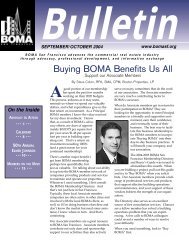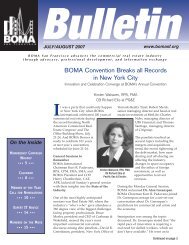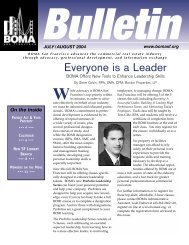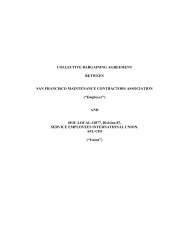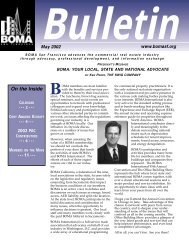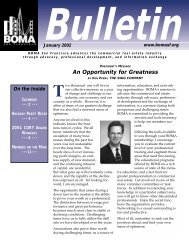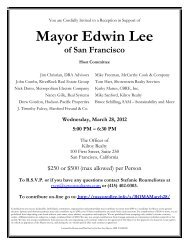- 1 - BEFORE THE PUBLIC UTILITIES COMMISSION OF ... - BOMA SF
- 1 - BEFORE THE PUBLIC UTILITIES COMMISSION OF ... - BOMA SF
- 1 - BEFORE THE PUBLIC UTILITIES COMMISSION OF ... - BOMA SF
Create successful ePaper yourself
Turn your PDF publications into a flip-book with our unique Google optimized e-Paper software.
<strong>BEFORE</strong> <strong>THE</strong> <strong>PUBLIC</strong> <strong>UTILITIES</strong> <strong>COMMISSION</strong><br />
<strong>OF</strong> <strong>THE</strong> STATE <strong>OF</strong> CALIFORNIA<br />
Application of Pacific Gas and Electric Company<br />
for Authority to Implement Default CPP Rate<br />
Options For Large Customers<br />
Application No. 05-01-016<br />
(Filed January 20, 2005)<br />
Southern California Edison Company’s (U 388-E)<br />
Application for Approval of Rate Design Proposal<br />
For Large Customers<br />
Application No. 05-01-017<br />
(Filed January 20, 2005)<br />
Investigation on the Commission’s Own Motion<br />
into the Rate, Operations, Practices, Service, and<br />
Facilities of Southern California Edison Company<br />
Application No. 05-01-018<br />
(Filed January 20, 2005)<br />
OPENING BRIEF<br />
<strong>OF</strong><br />
<strong>THE</strong> BUILDING OWNERS AND MANAGERS ASSOCIATION<br />
<strong>OF</strong> SAN FRANCISCO,<br />
AND<br />
<strong>THE</strong> BUILDING OWNERS AND MANAGERS ASSOCIATION<br />
<strong>OF</strong> CALIFORNIA<br />
March 14, 2005<br />
Bill F. Roberts, Ph.D.<br />
ECONOMIC SCIENCES CORPORATION<br />
1516 LeRoy Avenue<br />
Berkeley, CA 94708<br />
(510) 841-6869<br />
bill@econsci.com<br />
For:<br />
<strong>THE</strong> BUILDING OWNERS AND MANAGERS<br />
ASSOCIATION <strong>OF</strong> SAN FRANCISCO AND,<br />
<strong>THE</strong> BUILDING OWNERS AND MANAGERS<br />
ASSOCIATION <strong>OF</strong> CALIFORNIA<br />
- 1 -
<strong>BEFORE</strong> <strong>THE</strong> <strong>PUBLIC</strong> <strong>UTILITIES</strong> <strong>COMMISSION</strong><br />
<strong>OF</strong> <strong>THE</strong> STATE <strong>OF</strong> CALIFORNIA<br />
Application of Pacific Gas and Electric Company<br />
for Authority to Implement Default CPP Rate<br />
Options For Large Customers<br />
Application No. 05-01-016<br />
(Filed January 20, 2005)<br />
Southern California Edison Company’s (U 388-E)<br />
Application for Approval of Rate Design Proposal<br />
For Large Customers<br />
Application No. 05-01-017<br />
(Filed January 20, 2005)<br />
Investigation on the Commission’s Own Motion<br />
into the Rate, Operations, Practices, Service, and<br />
Facilities of Southern California Edison Company<br />
Application No. 05-01-018<br />
(Filed January 20, 2005)<br />
OPENING BRIEF<br />
<strong>OF</strong><br />
<strong>THE</strong> BUILDING OWNERS AND MANAGERS ASSOCIATION<br />
<strong>OF</strong> SAN FRANCISCO,<br />
AND<br />
<strong>THE</strong> BUILDING OWNERS AND MANAGERS ASSOCIATION<br />
<strong>OF</strong> CALIFORNIA<br />
In accordance with the procedural schedule established by the<br />
Presiding Administrative Law Judge 1 , the Building Owners and Managers<br />
Association of San Francisco (<strong>BOMA</strong> <strong>SF</strong>) and the Building Owners and<br />
Managers Association of California (<strong>BOMA</strong> Cal) hereby respectfully submit their<br />
conclusions, recommendations and supporting arguments regarding the<br />
implementation of default Critical Peak Pricing (CPP) rates for large customers.<br />
INTRODUCTION<br />
This Proceeding was predicated on regulator concerns stated in ACR<br />
02-06-001, “…that during the summer of 2005 there may be insufficient<br />
1 Administrative Law Judge’s Ruling Setting Prehearing Conference and Addressing Procedural Issues<br />
(February 1, 2005), page 4.<br />
- 2 -
generating capacity to meet system peak demand 2 ”. The ACR further<br />
expressed concern that existing demand programs do not provide a rational way<br />
to plan to serve an anticipated, ongoing supply shortage. The ACR ordered<br />
Pacific Gas and Electric (PG&E), Southern California Edison (SCE) and San<br />
Diego Gas and Electric (SDG&E) to file proposals for new default rate schedules<br />
for all customers over 200KW demand that provide strong peak demand signals<br />
while also preserving class revenue neutrality. The ACR further described the<br />
overall goal of the required filing as follows: “Our goal in directing the filing of<br />
applications for a new default rate structure is to provide sufficient economic<br />
incentive to large customers to predictably and systematically move their usage<br />
out of the critical peak period, and if they do not do so, have them pay an<br />
increased rate for usage during that narrow set of hours”.<br />
Responding to the ACR, the three utilities filed Critical Peak Pricing<br />
Applications which included various combinations of critical peak period charges,<br />
credits for usage during non critical peak periods, and hedging premiums for<br />
customers wishing to opt out of the CPP program. The Office of Ratepayer<br />
Advocates (ORA) also submitted a proposal for imposing CPP tariffs.<br />
Responding to a request from the Presiding ALJ, the three utilities also provided<br />
some analyses of the bill impacts of their proposals. ORA did not provide similar<br />
information claiming lack of customer data on which to perform the analysis.<br />
Testimony responding to these proposals has been filed in this Proceeding by<br />
the California Independent System Operator (ISO) and 16 other Parties<br />
2 Assigned Commissioner and Administrative Law Judge’s Ruling Directing the Filing of Rate Design<br />
Proposals for Large Customers (December 8, 2004), page 1.<br />
- 3 -
epresenting various end use customers and customer associations. Consistent<br />
with the record that has been established in this Proceeding, <strong>BOMA</strong> <strong>SF</strong> and<br />
<strong>BOMA</strong> Cal offer the following conclusions and recommendations:<br />
Conclusion 1- A Summer 2005 Capacity Shortage is Unlikely<br />
Recommendations:<br />
1A - Stay the course – develop voluntary demand response<br />
programs<br />
1B - Resolve regulatory issues that impede infrastructure<br />
development<br />
Conclusion 2 - CPP tariffs will not reduce summer 2005 peak demand<br />
Recommendations:<br />
2A - Expand and refine existing demand response programs<br />
2B - Revise Rule 18<br />
Conclusion 3 - CPP tariffs distort cost signals<br />
Recommendations:<br />
3A – Re-establish cost of service ratemaking principles<br />
3B – Make non cost based rates voluntary<br />
3C - Begin implementing market based real time pricing<br />
Conclusion 4 - CPP tariffs discriminate against office buildings<br />
Recommendation:<br />
4 - Avoid policies that target end uses<br />
Conclusion 5 – ACR 02-06-001 amplifies regulatory uncertainty<br />
Recommendation:<br />
5 – Return to fundamental cost of service rate policies<br />
Explanations and supporting arguments for these conclusions and<br />
recommendations are provided below.<br />
CONCLUSIONS AND RECOMMENDATIONS<br />
Conclusion 1- A Summer 2005 Capacity Shortage is Unlikely<br />
The fundamental ACR 02-06-001motivating concern, that there may be<br />
insufficient generating capacity to meet summer 2005 system peak demand, has<br />
- 4 -
not been corroborated in this proceeding. To the contrary, PG&E Witness<br />
Alvarez testified that “Northern California reserves are expected to exceed<br />
required operating reserve levels in summer 2005 and for several years after,<br />
even under extreme hot weather conditions” (Exhibit 1, page 2-2). Neither SCE<br />
nor SDG&E offered evidence of an impending summer 2005 capacity crisis for<br />
Southern California. However, ISO Witness Perez, in arguing for continuation of<br />
interruptible programs, testified that, “The CAISO shares the Commission’s<br />
‘substantial interest’ that capacity margins in California will be tight for summer<br />
2005” (Exhibit 215, page 3). In his Rebuttal Testimony, Witness Perez (with<br />
regard to Southern California), made reference to a CEC presentation entitled<br />
California’s Energy Situation: Summer 2005 (February 22, 2005) that he<br />
suggested, “continued to find a potential deficiency of approximately 1966 MW’s<br />
for September 2005”, (Exhibit 216, page 3). However, an examination of the<br />
CEC presentation (slide # 7) reveals that the deficiency referenced by Mr. Perez<br />
is a deficiency in maintaining the targeted 7% reserve margin, which is only<br />
expected to occur under 1-in-10 hot summer conditions. In conclusion, the<br />
record does not support the assumption of an impending capacity crisis for<br />
summer 2005 that might rationalize such drastic emergency measures as the<br />
imposition of hastily designed mandatory CPP tariffs.<br />
Recommendations:<br />
1A - Stay the Course - Develop Voluntary Demand Response<br />
Programs<br />
<strong>BOMA</strong> <strong>SF</strong> and <strong>BOMA</strong> Cal support PG&E’s preferred recommendation to<br />
“stay the course” in summer 2005 with existing demand response programs<br />
- 5 -
(Exhibit 1, pages 1-1 through 1-11). The Commission should focus on<br />
strengthening voluntary programs through enhanced (but cost effective) benefits<br />
for participation.<br />
1B – Resolve Regulatory Issues That Impede Infrastructure<br />
Development<br />
The fact that ACR 02-06-001 was issued on the expressed concern about<br />
insufficient generating capacity is stark testimony to the fact that regulatory<br />
uncertainty continues to impede needed investment in California’s generation<br />
and transmission infrastructure, four years after the great California Energy<br />
Crisis. Demand management can help reduce California’s need for expanded<br />
infrastructure but it can not do it all. Investment in generation and transmission<br />
will be necessary to support a growing California economy. Therefore, <strong>BOMA</strong><br />
<strong>SF</strong> and <strong>BOMA</strong> Cal strongly urge the Commission and the Legislature to<br />
accelerate efforts in resolving remaining issues of energy policy and market<br />
structure so that investment is encouraged, and unnecessary emergencies can<br />
be avoided.<br />
Conclusion 2 - CPP Tariffs Will Not Reduce Summer 2005 Peak Demand<br />
While the goal of ACR 02-06-001 was the reduction of summer 2005 peak<br />
demand, all but one CPP proposal was silent on declaring the level of 2005 peak<br />
demand reductions that were expected from the proposed CPP tariff. Only<br />
SDG&E offered an estimate (20-28 MW) and that estimate was not supported by<br />
anything more than a statement that a consultant’s model (CRA) had been used<br />
to estimate the potential demand reductions from the default CPP (Exhibit 9,<br />
- 6 -
page JM-6). While SDG&E did what they could to provide some estimate, it must<br />
be recognized that there is virtually no relevant data sample available to provide<br />
a basis for verifying the applicability of the CRA model to measuring the impact of<br />
the SDG&E default CPP tariff. As a foundation for rational policy, this estimate<br />
must be considered as little more than a shot in the dark.<br />
SCE included a description of an after the fact econometric study to<br />
estimate the impact of their CPP tariff but did not venture a forecast.<br />
PG&E also did not offer any specific demand savings estimates. This fact<br />
was acknowledged by PG&E Witness Bell in his cross-examination testimony. In<br />
his response to a question by Ms Woo, Mr. Bell stated, “Several parties have<br />
noted that PG&E has not provided a forecast of how much CPP response would<br />
result from – if our proposal were adopted. I don’t know how many customers<br />
would opt out. I don’t know how customers would respond, how those customers<br />
that did not opt out would actually respond to the new prices” (Transcript ,<br />
February 25, page 167). He then went on to speculate an upper bound of 100<br />
MW savings based on multiple assumptions, but did not provide a forecast.<br />
ORA also offered a CPP tariff proposal, but ORA did not provide any<br />
estimates of the demand savings that their proposal might achieve. In fact, ORA<br />
Witnesses Ross and Liang-Uejio, under cross examination from Mr. McCrea,<br />
revealed that the ORA proposal was not designed to meet demand reduction<br />
objectives but was designed to send an efficient price signal (Transcript,<br />
February 25, pages 96-100).<br />
- 7 -
While the record shows no credible estimates of summer 2005 peak<br />
demand savings that might result from the imposition of mandatory CPP tariffs,<br />
the record is replete with testimony from various end users and end user<br />
associations that explain why the customers that they represent could not<br />
significantly adjust their summer 2005 demand (<strong>BOMA</strong>, CLECA, CMTA, EPUC,<br />
BART, Walmart, J.C. Penny, Costco, CLFP, WPTF, ICP, CCEA, CIPA /COPE<br />
and CFBF). The primary reasons given were, first that end users have already<br />
made investments, adopted efficient energy practices, and have few remaining<br />
options for reducing demand. And, second, it takes too long to develop<br />
investment justifications, get budget approval, and accomplish physical<br />
implementation for additional demand savings to be realized by summer 2005.<br />
In summary, the logical conclusion to reach from this record is that the imposition<br />
of CPP tariffs will not be useful in pursuing the ACR 02-06-001 goal of reducing<br />
summer 2005 peak demand.<br />
Recommendations:<br />
2A - Expand and Refine Existing Demand Response Programs<br />
The Commission should preserve, refine and expand existing interruptible<br />
and other demand response programs as proposed by PG&E in its stay the<br />
course recommendation. The Commission should also make an aggressive<br />
effort to identify smaller office buildings that have not yet adopted efficient energy<br />
practices and tailor technical support, rebates and financing plans to encourage<br />
greater energy efficiency.<br />
- 8 -
2B - Revise Rule 18<br />
CPUC Rule 18 currently prevents commercial building owners from sub<br />
metering tenant electricity usage and billing tenants in accordance with<br />
measured usage. As was mentioned in <strong>BOMA</strong> <strong>SF</strong>’s Opening Testimony (Exhibit<br />
210, page 8), this Rule shields tenants from TOU price signals and hampers the<br />
realization of the energy efficiency benefits that such signals can be expected to<br />
produce. Modification of Rule 18 may be one of the simplest and cost effective<br />
ways of obtaining additional energy efficiency savings. This issue is being<br />
considered in Proceeding 04-08-038.<br />
Conclusion 3 - CPP Tariffs Distort Cost Signals<br />
CPP tariffs further distort the cost signals in TOU electricity prices. The current<br />
TOU rate schedules were thrown out of alignment with cost of service in 2001<br />
when most of the energy crisis costs were piled onto the commercial and<br />
industrial rate classes, and most heavily on the summer peak periods, without<br />
any attempt at cost of service justification. This was explained by PG&E Witness<br />
Bell during cross examination by Ms. Hasbrouck as follows:<br />
“Our on-peak rates for the Schedule E-19 and E-20 customers were nearly doubled in 2001 by<br />
the surcharges that were applied then and were applied in a proceeding that was conducted<br />
under a very short time line, rather like this one, and there was no cost basis to how those<br />
were added into the rates. We're trying to work them down over time. But, as a result, if you<br />
look at the rates that applied to on-peak service now, I don't think that you can say anything about<br />
them being cost-based. They are tariffs that were originally set before the rate freeze back in our<br />
1996 general rate case and were held fixed for a period of five or six years, and then we had what<br />
was referred to as the 3-cent rate increase adopted in 2001 that was actually more like 4, 4-1/2<br />
cents for these customers, and it wasn't applied on an equal-cents-per-kilowatt-hour basis, it was<br />
heavily tilted towards the on-peak period, and there wasn't a cost basis for how it was tilted<br />
toward the on-peak period. There was some hope that it would create a new price signal for the<br />
summer of 2001, but people were working around the clock to try and make the new rates work<br />
across Edison and PG&E -- I don't think that San Diego was part of that case, but it was really a<br />
case very similar to this one, and I think we created a lot of unintended consequences; and I<br />
- 9 -
don't think that our current on-peak rates have any relationship to costs right now”<br />
(Transcript, February 25, page 174)(emphasis added)..<br />
Now the CPP rates add additional charges on those schedules and peak rate<br />
periods, again without cost of service justification. While the utilities have tried to<br />
quickly design ACR 02-06-001 mandated tariffs there has been very little attempt<br />
to justify these tariffs as being cost based. ORA registered attempts at arguing<br />
that their CPP price signals are cost based while ignoring the current<br />
misalignment of commercial and industrial rates from cost of service. In<br />
conclusion, current commercial and industrial rates are not cost justified and<br />
possess neither the properties of efficient price signals nor of equitable service<br />
cost allocation factors.<br />
Recommendations:<br />
3A – Re-establish Cost of Service Ratemaking Principles<br />
The implications of electricity price distortions from true cost of service are<br />
both inequitable assignment of costs across customers and inefficient<br />
consumption of electricity. Both of these implications also imply drags on the<br />
productive operation and growth of the California economy. The CPUC is<br />
arguably the most significant economic policy entity in the state, and it is<br />
important for economic recovery that the CPUC move immediately to re-establish<br />
cost of service ratemaking principles and correct the damage caused by past<br />
policy decisions. <strong>BOMA</strong> <strong>SF</strong> and <strong>BOMA</strong> Cal urge the CPUC to seriously consider<br />
the many pleas for a cost of service basis in electric rates that have emerged in<br />
this Proceeding.<br />
- 10 -
3B – Make Non-Cost Based Rates Voluntary<br />
Cost of service principles have been the foundation for electricity<br />
regulation in the United States for many decades, so much so that non cost<br />
based rates are not generally accepted by ratepayers as legitimate. That has<br />
certainly been born out in this Proceeding. The overwhelming majority of Parties<br />
have questioned, or made references to, the cost of service basis of CPP rates.<br />
While a cost of service basis is essential for default rates, there may be<br />
legitimate reasons to provide optional rates that are designed to promote<br />
administrative objectives that are not consistent with service costs. Such rates<br />
should only be offered to ratepayers as voluntary options. This includes any<br />
version of CPP rates that the Commission may wish to retain.<br />
3C - Begin Implementing Market Based Real Time Pricing<br />
<strong>BOMA</strong> <strong>SF</strong> and <strong>BOMA</strong> Cal urge the Commission to transform its interest in<br />
dynamic pricing into the design and implementation of market based real time<br />
electricity pricing for all bundled utility customers. We believe that modern<br />
metering and communications technologies make universal real time electricity<br />
pricing both feasible and in the public interest. In contrast to CPP (which is not<br />
cost based, is discriminatory, and distorts efficient prices), market based real<br />
time pricing provides a true cost foundation for electricity pricing and the most<br />
equitable means of allocating electricity commodity costs across all utility<br />
customers. Market based real time pricing also provides the most efficient price<br />
signals for guiding energy consumption decisions and for evaluating public<br />
efficiency and demand management programs.<br />
- 11 -
With the ISO’s new market implementation on the horizon, It is time to<br />
begin taking retail electricity commodity pricing out of the contentious and<br />
politically charged hearing room, and allow prices to be resolved by the impartial<br />
wholesale markets. It is our view that every utility customer should have the right<br />
to receive timely information about the costs of the power that he or she is<br />
consuming and to manage their power costs as they choose. Today, the<br />
provision of such information should be as much a part of the electric system<br />
infrastructure as are hookups and meters. Armed with timely, accurate<br />
information, consumer’s independent decisions will yield an efficient, demand<br />
responsive electricity market to the joint benefit of all consumers.<br />
Conclusion 4 - CPP Tariffs Discriminate Against Office Buildings<br />
The penalty/credit structure of CPP tariffs has been designed to<br />
discriminate against the end uses of commercial office buildings on unsupported<br />
assumptions about the discretionary nature of air conditioning and lighting load,<br />
and about the impact of peaky daily load shapes on peak demand growth.<br />
Numerous references in the testimony of the parties, hearing transcripts, and<br />
even the ACR, appear to assign blame for California’s peak demand growth on<br />
consumers with peaky daily load shapes that are the result of their discretionary<br />
air conditioning and lighting end uses (particularly commercial office buildings).<br />
For example, the ACR states the following: “Customers between 200 and 500<br />
KW may have more air conditioning load, and their class load profiles generally<br />
- 12 -
align more closely with the system peak than the largest customers, so they may<br />
have more load capable of shifting off the critical peak” (ACR, page 4).<br />
In his cross examination by Mr. Yates, PG&E Witness Mayers explicitly<br />
mentioned targeting office buildings as follows: “What we try to do is we tried to,<br />
as best we could, minimize the impact on customers taking into effect the<br />
processing and manufacturing. In fact, we -- we followed the suggestion in the<br />
ACR which suggested that between 200 and 500 kW generally air-conditioning<br />
load is more prevalent and more discretionally -- discretionary load is available<br />
for those customers, and that's on a general matter there's nothing in those rates<br />
to differentiate a manufacturing customer from, say, a -- an office building, for<br />
instance “(Transcript, February 25, page 140).<br />
Using these same unsupported assumptions about air conditioning and<br />
load shapes, representatives of industrial, agricultural and other energy users<br />
have attempted to deflect the application of CPP from their constituents by<br />
arguing that the flat or inverted daily load shapes of their constituents do not<br />
contribute to peak demand.<br />
<strong>BOMA</strong> <strong>SF</strong> and <strong>BOMA</strong> Cal believe that the basic assumptions that lead to<br />
this discriminatory targeting of commercial office building end uses are false, and<br />
the CPP rate design that derives from those assumptions is both misguided and<br />
harmful to California business. First, air conditioning and lighting loads in<br />
commercial buildings are not discretionary. This point was made in <strong>BOMA</strong>’s<br />
Rebuttal Testimony as follows: “While often referred to as discretionary comfort<br />
and convenience services, air conditioning and lighting in commercial buildings<br />
- 13 -
are actually critical components of the services that buildings provide to support<br />
the business operations of their tenants. For both practical business productivity<br />
reasons and contractual reasons, these services must be provided within very<br />
narrow tolerances of temperature and lighting levels” (Exhibit 211, page 5).<br />
While it may be true, that some air conditioning loads for some customers<br />
are discretionary and incentive programs might be effective in reducing such<br />
usage. However, it is simply bad policy to use a broad brush assumption that all<br />
air conditioning and lighting load is discretionary and set tariffs to punish those<br />
customers who do can not or will not reduce those end use loads.<br />
The second false assumption that appears to drive the discriminatory<br />
CPP rate design is that peaky load shapes are the cause of the growth of<br />
California’s system peak demand. The fact is that the shape of daily load<br />
curves is irrelevant to peak demand growth. California’s peak demand<br />
problem is one of year to year demand growth so the only aspect of a customer’s<br />
load that is relevant to peak demand growth is the annual change in customer’s<br />
load that is coincident with the system annual peak. To examine this issue,<br />
assume that three utility customers (A, B, & C), each have demand of exactly 1<br />
MW at the time of the annual system peak (say 4:00 P.M. on August 20).<br />
Suppose also that Customer A has a peaked daily load shape that hits its peak at<br />
4:00 P.M., Customer B has a perfectly flat daily load curve that is always exactly<br />
1MW, and Customer C has an inverted daily load curve that reaches its minimum<br />
of 1 MW at 4:00 P.M. Each of the three customers account for exactly the same<br />
demand at the system peak and impose the same costs on the system.<br />
- 14 -
Whatever happens to the load levels of the three customers on either side of the<br />
peak is of no significance to peak demand or the system costs at peak demand.<br />
Thus, the only portion of the daily load shape is relevant to system peak demand<br />
and cost is the quantity of demand on the load curve that is coincident with the<br />
system peak. Furthermore, it is only the year to year growth of the single point on<br />
the daily load curve that is coincident with the next annual peak that is relevant<br />
for assigning responsibility for peak demand growth and cost. The year to year<br />
growth may be more likely to come from the customers with the flat or inverted<br />
daily load curves (from sales growth and expanded operations) than from a full<br />
occupancy commercial office building that has the same peaky load every<br />
business day of the year. A detailed discussion of the peaky but stable load<br />
curves of efficient office buildings was presented in <strong>BOMA</strong> <strong>SF</strong>’s Opening<br />
Testimony (Exhibit 210, pages 4-6). This said, there may be some office<br />
buildings that have not adopted best energy management practices such that<br />
their buildings show substantial seasonal variations in load that could be modified<br />
over time, given adequate investment. However, focusing punitive behavior<br />
modifying tariffs on all commercial buildings on the false assumption that peaky<br />
daily load shapes are the cause of system peak demand growth distracts the<br />
Commission from discovering the true nature of the problem and devising more<br />
effective policies.<br />
- 15 -
Recommendation:<br />
4 – Avoid Policies That Target End-Uses<br />
It is not the role of the Commission to decide what end uses should consume<br />
electricity and which should not. It is the role of the Commission to set just and<br />
reasonable rates that consumers factor into their own choices as to how much<br />
electricity that they will consume. Devising rate policy that discriminates for or<br />
against any end use is a slippery slope that does not have a positive outcome<br />
and should be avoided by the Commission.<br />
Conclusion 5 – ACR 02-06-001 Amplifies Regulatory Uncertainty<br />
The intent of the ACR is widely interpreted, at least by commercial building<br />
owners, as one of designing punitive rates to force consumers to modify their<br />
behavior in a manner that suits administrative goals. Both the stated goal of the<br />
ACR and the CPP tariff structures that the utilities have developed in response to<br />
the ACR lend support to that interpretation.<br />
The ACR also rekindles fears of another capacity shortage four years after<br />
the energy crisis, and puts focus on the failures of California policy makers to<br />
resolve the policy issues that continue to hinder the development of an<br />
infrastructure that would provide adequate capacity. For both of the above<br />
reasons, the ACR has significantly increased business uncertainty about the<br />
productivity, rationality, fairness, and stability of CPUC. This increased<br />
uncertainty will undoubtedly have a dampening impact on business investment in<br />
- 16 -
California at a time when the economy is struggling to pull out of the worst<br />
recession in decades.<br />
Recommendation:<br />
5 – Return to Fundamental Cost of Service Rate Policies<br />
The best outcome of this Proceeding is for the Commission to reject all of<br />
the CPP Applications, to reaffirm a commitment to cost of service ratemaking<br />
principles, and to begin the development of plans for the implementation of<br />
universal market based real time pricing.<br />
<strong>BOMA</strong> San Francisco and <strong>BOMA</strong> California appreciate the opportunity<br />
to provide this input to the Commission.<br />
Respectfully submitted,<br />
Bill F. Roberts<br />
President<br />
Economic Sciences Corporation<br />
1516 LeRoy Avenue<br />
Berkeley, CA 94708<br />
(510) 841-6869<br />
bill@econsci.com<br />
for:<br />
The Building Owners and Managers Association of San Francisco and,<br />
The Building Owners and Managers Association of San Francisco<br />
- 17 -
CERTIFICATE <strong>OF</strong> SERVICE<br />
I hereby certify that I have this day served a copy of the Opening Brief of<br />
the Building Owners and Managers Association of San Francisco and the<br />
Building Owners and Managers of California on all known parties of record in<br />
this proceeding by delivering four copies and one original to the CPUC’s San<br />
Francisco Docket Office and via email to all parties on the service list.<br />
Executed on March 14, 2005 at Berkeley, California.<br />
___________________<br />
Valborg T. Roberts<br />
Economic Sciences Corporation<br />
1516 LeRoy Avenue<br />
Berkeley, CA 94708<br />
(510)841-6869<br />
vali@econsci.net<br />
- 18 -



